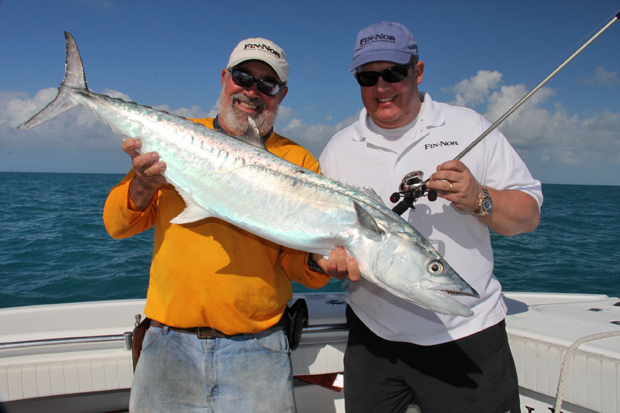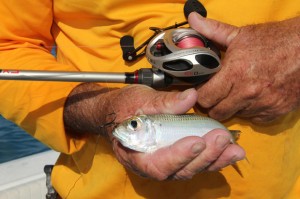August 08, 2013
By Florida Sportsman Editor
Go long for summertime kingfish.
 High-test, low-diameter braid spools up ocean-grade capacity on a modern low-profile baitcaster.
High-test, low-diameter braid spools up ocean-grade capacity on a modern low-profile baitcaster.
Looking for a real rush this summer? Take your bass tackle to the offshore reefs and go after kingfish.
Finding kings is a snap: Go where the bait is, or where the reefs are, usually 30 to 80 feet of water. Kings are widespread in Florida this time of year, but especially thick off the northern sides of the peninsula, and west through the Panhandle. Pick a port: Boca Grande, Clearwater, Destin, and others on the Gulf side. Port Canaveral, Ponce Inlet, Fernandina and more on the Atlantic.
Now, you can slow-troll big live baits like the tournament guys do, or pull spoons and rigged baits like the charterboats. Better yet, lighten up and fish live bait on the same rigs you used during the spring bass spawn on Florida lakes!
 It's just saltwater shiner fishin', after all.
It's just saltwater shiner fishin', after all.
Here's the game plan:
Start a Frenzy: Anchor in a likely area, then set out frozen block chum in a meshbag. As it thaws, it attracts and holds kingfish with a scent trail that appeals to predators, along with the forage they seek. Over reefs, wrecks and rockpiles, expect jacks, blue runners, Spanish sardines and various snappers to gather in your chum line. Kings can't resist all this activity, but amid all the rod-bending, don't let the chum dwindle. Captain R.T. Trosset, who guides in Key West, says kingfish interest is easy to attract, but easier to lose. He employs tactics that transfer perfectly to all parts of the state. Keep the kings close with a consistent chum effort. Shake the chumbag frequently and spice up the slick with small bits of cutbait and or
handfuls of glass minnows.
Rod and Reel: Spinning or conventional reels must have smooth drags to withstand blistering runs and sudden bursts late in the fight. Rods of at least 7 feet are most efficient at tiring fish, plus you'll appreciate the reach when a king runs around the motors or the bow.
Line Capacity: For any reasonable shot at outlasting a king's sprints, Trosset recommends at least 150 yards of line. With monofilament, the lighter you go, the more you can fit on that smaller spool. Braided line affords maximum yardage with the superior strength to endure the sudden impact of a kingfish strike. A 3-foot section of 20- or 30-pound-pound fluorocarbon, attached with a double-uni knot, helps absorb some of the bump, while withstanding a king's stiff tail, which beats against fishing line when the fish makes a straightaway sprint.
Ready to Run: A big king will test your light tackle spool capacity and dumping a football fieldplus of line into the ocean is never a good idea. Avoid this by rigging a boat fender or other large float to your anchor line so you can quickly detach to chase a big king and then return to your anchor position. (Tip: Zip-tie a chumbag to the anchor float to continue seeding the area while you're away.)
Terminal Tackle: A single No. 6 treble on 12 to 24 inches of No. 3 or 4 wire leader provides plenty of kingfish-nabbing gear without overburdening a smaller bait. No need for stinger rigs, as kings of all sizes will gobble pilchards whole. Moreover, trailing hook rigs work better for trolling presentations when the fish have less time to inspect a bait.
Trosset links his fluoro leader to his wire with an Albright knot, rather than a swivel, as mackerel often strike at the latter and that'll doom your light tackle pursuit in a hurry. Keep in mind that the micro guides common to modern bass tackle and some inshore gear are too tight for knot passage. You'll typically just drop your baits into the chum line and feed out line, but be careful not to reel leaders up to the tip, as the impact can damage the insert.
Rodwork: Keep the rod at about 10 o'clock, don't wind when the fish runs and get ready to stick the rod tip in the water if your fish dashes under the boat. During a fight, work a king in circles to keep the line on the same side of its head. When a fish switches passing side, the leader shifts across its mouth and that can tug at the hook hole enough to open the skin and cause an early release.
End Game: You might want to keep a few kings for the grill, but the majority you'll release. Get used to handling kings without a gaff: Reach down and grab the tail, hoist the fish up and get a hand under the belly, careful not to let that toothy maw swing your way. Have a buddy quickly unhook the fish with pliers (or snip the leader), and jet the fish back into the water quickly, headfirst. - FS
First Published Florida Sportsman July 2012

